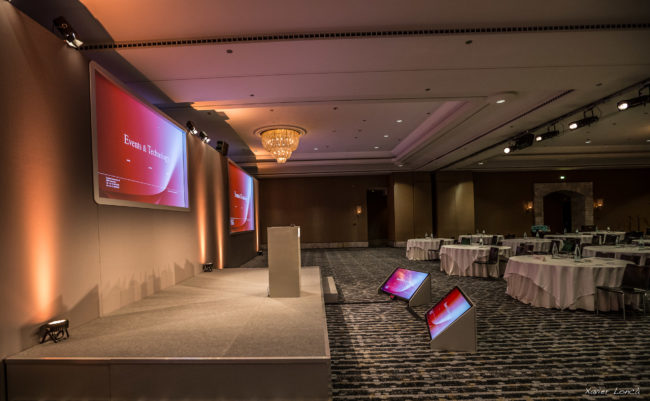
Presenting Tip #6: Don’t Use Confidence Monitors
Last year Kellogg opened up its new Global Hub, a massive and fabulous building that is now perhaps the top business school facility in the world. The building is full of light and incredible vistas of Lake Michigan, with a mix of meeting spaces and areas for quiet work and reflection. The classrooms are modern and spacious.
There is just one problem (aside from the rather limited number of bathrooms!): All the classroom have confidence monitors, and these devices do not enhance the teaching experience for most presenters.
Confidence monitors are the video screens placed just in front of a speaker. With a confidence monitor you don’t need to look back at the big screen behind you; you just glance down at the screen directly in front of you.
The Appeal
At first look, confidence monitors make a lot of sense. You don’t need to look back, so you don’t lose your connection with your audience. You reduce the risk that you will make the classic presenting mistake of looking mainly at the screen and not your audience.
The Problem
In reality, confidence monitors often do more harm than good. When giving a presentation, you want to connect with your audience. The best way to do this is with eye contact; you glance at one person, hold the look for a few seconds while you explain your point, then you move on to the next person.
The problem with a confidence monitor is that every time you glance at it you lose the connection. You are no longer looking at your audience; you are looking at your screen. The problem is accentuated because in many cases the monitor is either lower than your audience, so you look down, or higher than you audience, so you look over their heads.
People often focus on and talk to the confidence monitor, in part because it seems like a fine thing to do. Looking back at the screen and turning away from your audience for an extended period is clearly a bad move. Looking at the confidence monitor, on the other hand, seems like a natural and logical thing. Unfortunately, the impact is the same; you have lost your connection.
If you are presenting well, you have complete control of the audience. People are looking at you. When you want them to look at the screen you look at the screen and they follow your gaze. Then you turn back and they look at you again. You control everything: “Look at me, look at me, now look at the screen, now look at me, now look at the screen and that number in the center, now look back at me.”
So if you find yourself in a room with a confidence monitor, simply unplug it. This will eliminate the risk. If you can’t unplug it, cover it up or turn it off. The goal is simply to reduce the chance that you will use it.
Confidence monitors are almost too easy; they seem like wonderful tools but will actually do notable damage to your presentation.
For more presenting tips and suggestions, track down a copy of my new book How to Wash a Chicken or visit the website.
I’ll have to disagree on this one. Rather than throwing the baby out with the bathwater, as the old saying goes, presenters should use confidence monitors correctly rather than dispense with them entirely. Every great speaker will be connecting continuously with his or her audience, but having a confidence monitor you can catch out of the corner of your eye is absolutely worth it. One should *never* “speak to the monitor”, but turning around to check the main screen is a much, much bigger no-no. Every major venue, from TED on down, is set up with confidence monitors, and I have my own I can bring for places that don’t…even though I am intimately familiar with my slides and don’t “need it”.
If Barack Obama, quite possibly the greatest speaker of our time, can use a Teleprompter when necessary, the typical presenter would be well-served by a discreet downstage confidence monitor rather than a podium laptop, backward glances at the main screen…or using slides blind.
Completely agree. And stand near the PowerPoint screen so viewers can see the screen without taking their eyes (much) off of you.
Good advice. And I’ll go one better: stand to the LEFT side of the screen (from the audience’s perspective) their eyes can go from you to the screen the way they naturally read…
David—Great point. We naturally read left to right so best to stand on the left side.